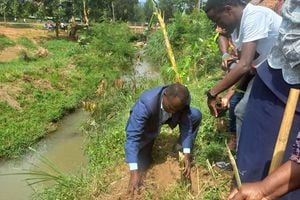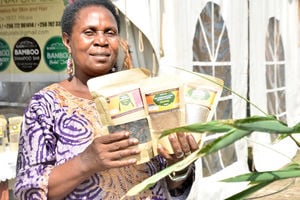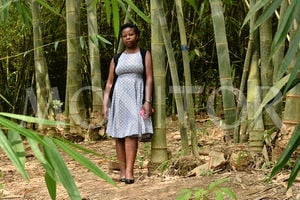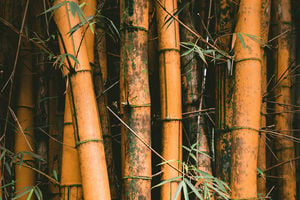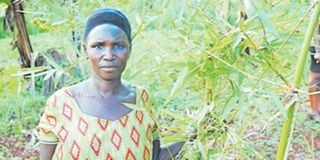
A farmer explains the value chain of bamboo farming. PHOTO COURTESY
Uganda’s population continues to grow and so does the demand for fuelwood and wood products.
Agriculture is also expanding into natural woodlands and forests. The resulting deforestation worsens climate change and its impacts.
Further, forest plantations are failing to keep pace with the demand for wood and wood products. One promising option to change this challenge is to interest the farming community to grow bamboo which can be harvested over a long period of time.
Bamboo is not new to Uganda and although most of the bamboo resource is in protected areas, adjacent communities have already explored its use for food, construction, craft materials, fuelwood and other utilisations.
Realising the untapped potential of bamboo, Uganda has developed the National Bamboo Strategy 2019–2029 as a framework to support the development of the bamboo sector, allowing the private sector, both smallholder farmers and industrial plantation companies, to play a major role.
In a publication by the International Bamboo and Rattan Organisation (INBAR) produced as part of the Dutch-Sino East Africa Bamboo Development Programme Phase II funded by the Ministry of Foreign Affairs of the Kingdom of the Netherlands and the National Forestry and Grassland Administration, China the team partnered with scientists at the National Agricultural Forestry Resources Research Institute to identify the viability of Bamboo farming in the country.
In Uganda the search work was carried out by a team of scientists in NaFORRI led by Dr Hilary Agaba and below are the details:
Ugandan bamboo sector
Uganda has low bamboo species diversification, the reason scientists are conducting research to establish good species that can be adopted by the farming community.
The two dominating indigenous species are O. alpina K. Schum highland bamboo and O. abyssinica A. Rich lowland bamboo.
These bamboo species mainly occur in natural stands in protected areas where they are estimated to cover an area of 54,533 hectares.
The lowland bamboo O. abyssinica is found in northern Uganda and West Nile, mainly in Otzi Mountains, Metu and the Agoro-Agu Central Forest Reserve. The Otzi Forest Reserve located in Moyo District is famous for its rich biodiversity. There has been evidence of the presence of chimpanzees. It is also well-known for the White Rhino Sanctuary. The total area where bamboo grows is 87.74 km2 in Otzi Mountains and Metu. The Agoro-Agu Central Forest Reserve is located at the border between Uganda and South Sudan.
The vegetation of this area includes Afromontane forests, shrublands, woody grasslands, and bamboo.
Highland bamboo O. alpina naturally occurs on Mt Elgon, on the Rwenzori Mountains, at the Mgahinga Gorilla National Park and in the Echuya Central Forest Reserve. The bamboo belt covers 342.01 square km. The Rwenzori Mountains, located in the equatorial zone, border Uganda and the Democratic Republic of the Congo.
These mountains have different vegetation zones, including tropical rainforests, bamboo, montane cloud forests, heathlands, afro-alpine plants, bare rocks and snow.
The bamboo layer is between the two forest layers with an estimated overall area of 191.00 square km.
Restoration process
Since 2016, the INBAR has been implementing the Dutch-Sino East Africa Bamboo Development Programme in efforts to stimulate farmers’ and other stakeholders’ interest in bamboo growing in Uganda.
In 2019, the Uganda National Bamboo Strategy and Action Plan for 2019–2029 were launched to promote bamboo development in the country.
Uganda aims to restore 375,000 hectares of degraded forest land with bamboo by the year 2030.
These efforts have been critical to the introduction of other bamboo species in the country.
Exotic species
The exotic species, B. vulgaris is naturalised and the most successfully cultivated bamboo species in Uganda because it is easily propagated through vegetative propagation methods and therefore is the most common bamboo species in most nurseries across the country.
In addition, Phyllostachys aurea is a bamboo species common in urban areas and used for landscape modelling. Other bamboo species have been recently introduced, such as Bambusa balcooa Roxb, D. asper, Backer, B. polymorpha Munro, Dendrocalamus membranaceus Munro, D. giganteus Munro, D. strictus, Nees, Bambusa bambos Voss and Dendrocalamus longispathus Kurz.
Many nurseries have taken up bamboo multiplication to respond to the growing demand for planting material in the country.
NaFORRI was contracted by INBAR to conduct a bamboo site species suitability matching study for Uganda. This was to validate the growth and performance of indigenous and introduced bamboo species and provide recommendations for the expansion of selected species for different agro-climatic clusters and end uses.
Results
Growth performance data were collected by establishing temporary sample plots 20m by 20m in each bamboo stand to measure growth.
The growth performance of B. vulgaris at three years in the three Lake Victoria crescent, West Nile and southern highlands was comparable to that reported elsewhere.
LIMITATIONS
The limitations included the uneven distribution of bamboo species in all the agro ecological zones. This limited the data collection and comparison to only a few agro ecological zones where sufficient data for given species could be established

